Alaska and the Pacific in the 1940s
An Interview with Madeline Charvet Smith
by Mary Lou Bigelow
Madeline Charvet Smith, one of Pan Am’s early stewardess pioneers, navigated the globe with Pan American from 1946 to 1951. She continues to amaze us younger ones!

At a vibrant 91, we see little evidence of Madeline slowing down. She still loves her tennis, yoga, cross-country skiing and golf at the Lake Waramaug Country Club near her home in Washington, CT. She continues to attend Pan Am gatherings, such as the Pan American Historical Foundation luncheon organized by Dick Blair in Port Chester, NY; Captain Alan Vale’s Clipper Pioneer (Pan Am pilot’s organization) monthly luncheons in Danbury, CT and the Boston Chapter World Wings International events throughout New England. And, she rarely misses Captain Stu Archer’s annual cruises.


Madeline recently returned from Vancouver, WA where she participated in the 2015 U.S. Tennis Association (USTA) matches. She won the national singles title for ages 70 + and was runner-up in doubles with partner Jacquie Van Haelst. As you can see, Madeline lives life with gusto!
How did Madeline become interested in flying as a career? In high school, she recalls doodling airplanes at her desk. No one in her family was involved in aviation, but a few male friends had their own airplanes, so she would take a ride with them from time to time.
Following high school, she attended Yakima Business College in her home town of Yakima WA for six months. Following graduation, she worked for the Washington State Tax Commission, but she dreamt of becoming a stewardess. She wrote letters to Pan Am, TWA, and United – the three airlines with bases in Seattle, but she learned she needed to wait until she reached 21. Disappointed, she attended Seattle College, a small four-year Catholic Jesuit College, now called Seattle University.
A year and a half later, in March 1946, Pan Am called to interview her in Seattle. This was to be the second class that Pan Am ever hired in Seattle. The rules stated, she recalls, “that all stewardesses must be between 5’2” and 5’4″.” She measured a bit under that, but she was accepted, anyway. She realized then that the height restriction was simply a guideline, because she noticed that one girl in the previous class was 5’8″!

One of only five in her graduating class, she and her classmates got along well and remained friends for years. Madeline had her own apartment in Seattle at the time but welcomed one of the girls from the third class to room with her. Jean Iverson remained her roommate for the rest of her flying career.
As for training, she recalls taking a physical exam, attending four weeks of ground school and then taking a familiarization flight over Seattle.

Pan Am had a very small base with just a few crews for the DC3’s. In the 40’s Alaska was still a territory and not yet a state, adventure was in the air! Madeline’s trips were Juneau, Alaska turn arounds and a Fairbanks, Alaska trip with a two-to-three day layover.
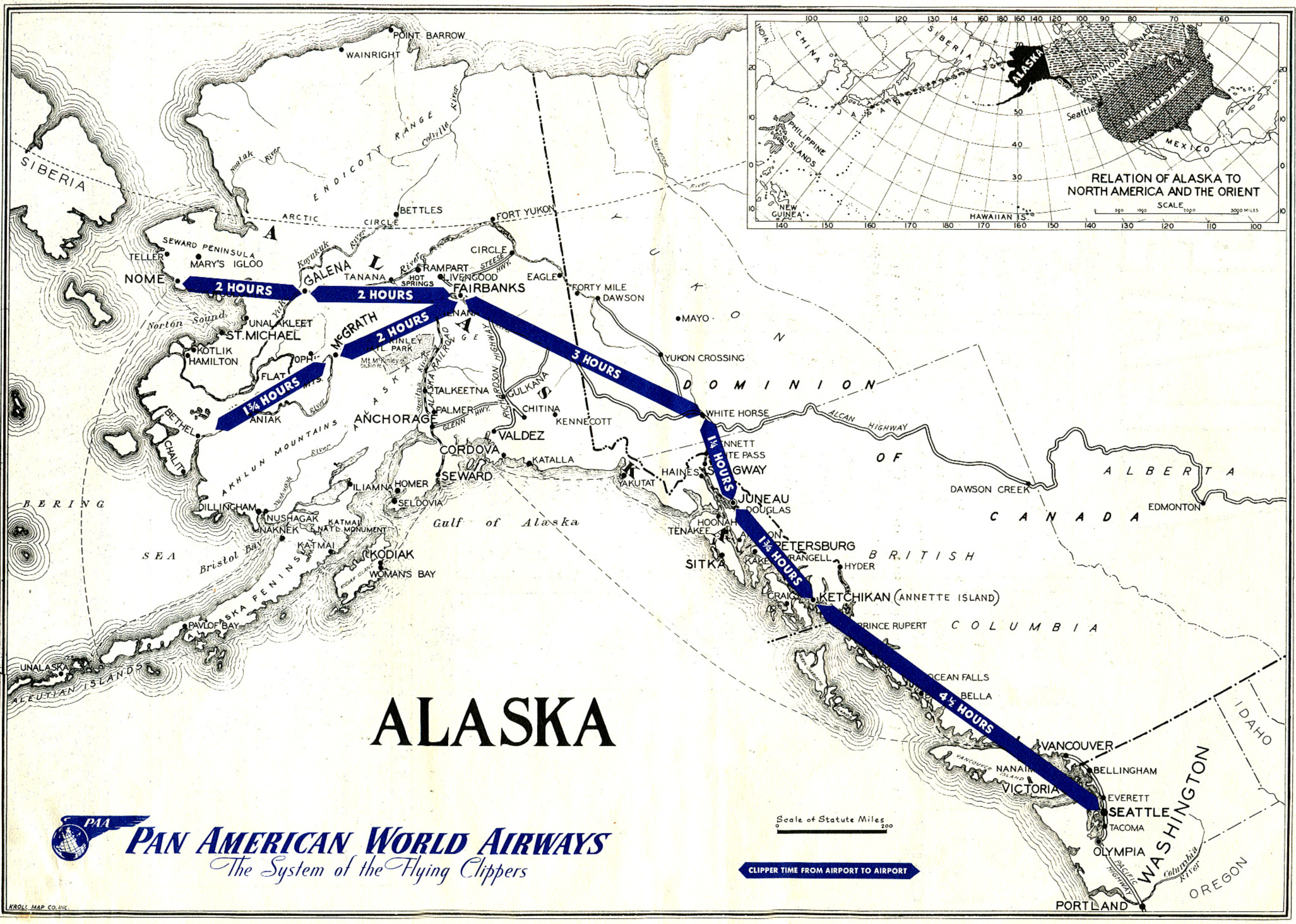
“Often, especially in the winter, we would end up stuck a week in Fairbanks and or days in Juneau. We also used some alternates due to weather, such as Annette Island, Alaska; White Horse, Canada and Port Hardy, Vancouver Island,” she said.

Once in a while, Madeline would bid a week’s stay in Fairbanks, where she would fly every other night to Bethel, Nome and Kotzebue and then back to Seattle. On one occasion, she sent a Western Union message to her aunt’s relative – Father Frank Menage, a Jesuit missionary stationed in Kotzebue.
 “We usually carried first class mail on these flights,” she said, “so when we arrived late one evening in 1947, Father Frank arrived by dogsled across the frozen river to pick up the mail and to visit with me. The terminal was a small shack with a pot-bellied stove. I clearly remember how we stood by the stove warming ourselves as we talked while the ground crew serviced and refueled the aircraft.”
“We usually carried first class mail on these flights,” she said, “so when we arrived late one evening in 1947, Father Frank arrived by dogsled across the frozen river to pick up the mail and to visit with me. The terminal was a small shack with a pot-bellied stove. I clearly remember how we stood by the stove warming ourselves as we talked while the ground crew serviced and refueled the aircraft.”

After six months in Seattle, Pan Am replaced the DC3’s with DC4’s and began hiring new stewardesses. Madeline and the other experienced stewardesses checked out as pursers.

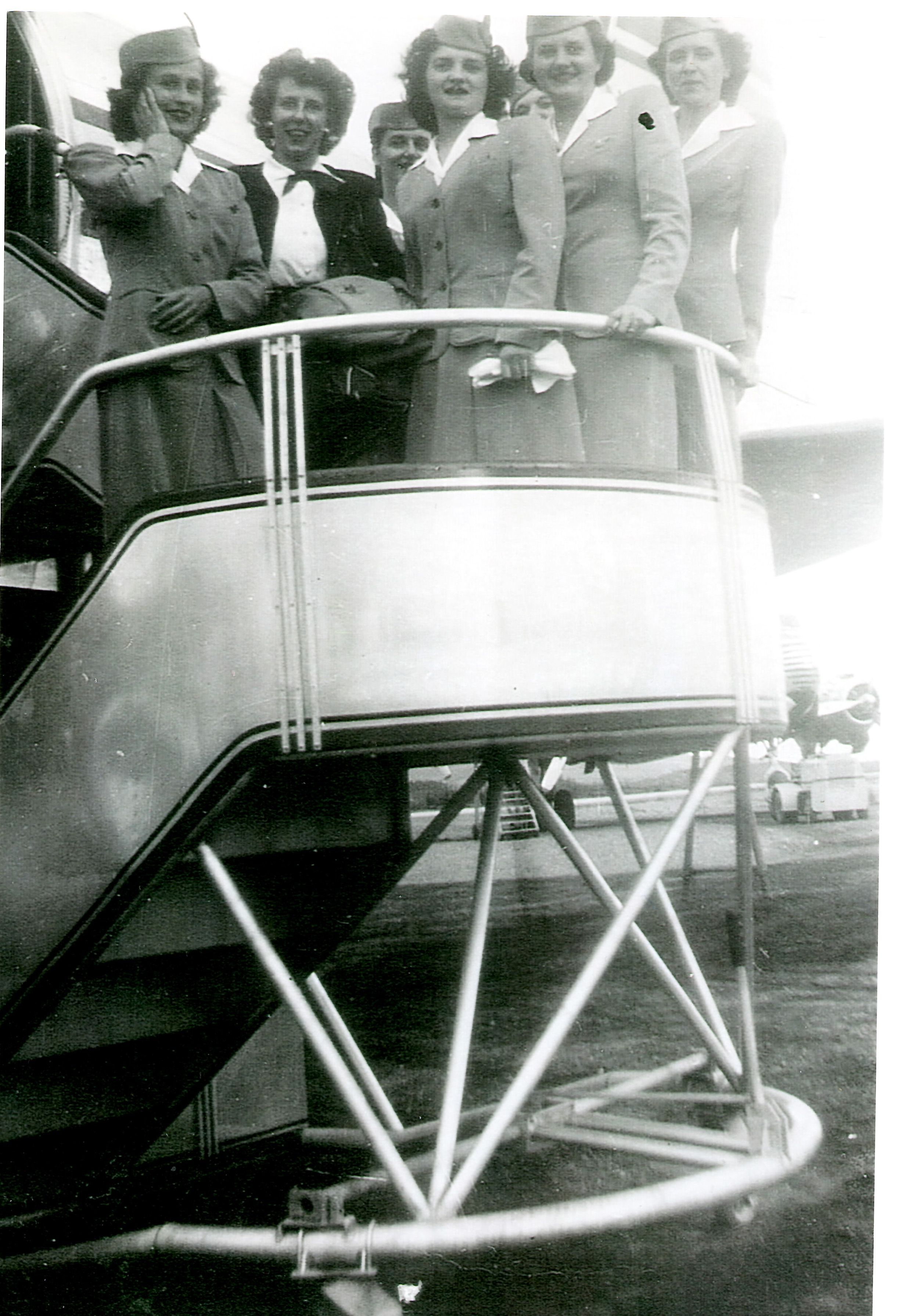
In October 1947, she and roommate Jean applied for a transfer to the San Francisco base along with Lois Thompson and Barb Fowler from the previous class. Because they were all checked out as pursers on DC-4s, they were quickly accepted. The four girls found a three-bedroom ranch to share in San Mateo, CA.

At first, the girls were assigned to short trips to Honolulu (HNL) and back as well as what were called “double V” trips – San Francisco (SFO) to HNL to Los Angeles (LAX) to HNL to SFO. “We were still flying DC-4s with one purser and one steward or stewardess,” Madeline said, ” carrying only 44 passengers. We liked those trips best, for being at home more often.”

Pan Am “Round-the-World” flights 001 (westbound) and 002 (eastbound) were inaugurated by Pan Am founder Juan Trippe earlier in 1947. The new Lockheed Constellation 749 flew as Flight 002 across the Atlantic from New York to Calcutta (now Kolkata, the capital of West Bengal, India), but in Calcutta, a DC-4 continued the flight to San Francisco. Madeline’s first long flight pattern on Pan Am 001 was in December 1947 on the DC-4 portion from SFO to Calcutta. Her crew consisted of six men – the captain, co-pilot, two engineers, radio officer and steward.
The flight pattern took Madeline and the crew from SFO to HNL, Midway, Wake, Guam, Manila, Hong Kong (HKG), Bangkok (BKK) and finally Calcutta, where the Lockheed Constellation 749 continued Flight 001 onward to New York. Madeline recalled spending two to three days at most stops. All in all, they were gone about 21 days.
Madeline’s memories in her words:
“In Honolulu, we stayed at the Moana Hotel at Waikiki Beach with its lovely verandah, large rooms with high ceilings and spacious bedrooms. We looked forward to spending time by the Banyan Tree on the beach side for dining and dancing to live music under the stars. I was given a private room unless another Pan Am crew was in, and then we girls would share.

On Wake Island, we spent our two to three days walking along the beach and fishing off the grounded Japanese ship Suva Maru, which was captured during World War II. lt was partially submerged in the water, tilting to one side about 30 degrees so that we had to climb aboard by a rope ladder and fish off its beautiful teak decks.
All the buildings were Quonset huts including the mess hall, recreation room and sleeping quarters. The indoor recreation room was for card games, reading, occasional radio and record playing. Of course, always popular in such a tropical zone – a bar with plenty of beer. Occasionally someone from the Navy base invited us to their small officers’ club.
Guam, our next stop, was similar to Wake, but a much larger island with two airports and a busy naval base. Our lodgings were Quonset huts like Wake. Our entire crew was usually invited to the Navy base for swimming and parties.

We only made a stop at Manila and flew on to Hong Kong, staying at the Peninsula Hotel in Kowloon. We took the ferry, a mere five cents per person at that time, across the bay to Victoria Island where we did a lot of shopping, touring and meeting up with the crew for dinner before returning to Kowloon by ferry.

Our next layover was Bangkok and what an interesting and unique city with all its canals and friendly people. I was most impressed with the beautiful temples.
We arrived in Calcutta at dusk. A wooden shuttle bus took us from the airport to our hotel. As we approached the city, we saw people lying on the sidewalks, sacred cows by their side; over crowded streets; and the heavy air of smoke, incense and smog.
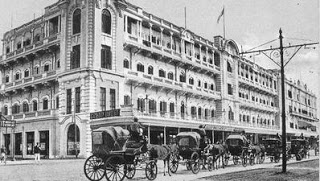
We checked into the Grande Hotel, a British-built hotel dating back to the twenties. It covered an entire block and had three annexes. The male crew checked into a large dorm-like room on the second floor above the lobby. I was given a room on the first floor at the end of an annex, quite a long distance from the lobby. Three young boys assisted me with my luggage when one would have sufficed! As we walked down the long corridor, we had to step over a couple of people curled up asleep in the hallway! When I opened the door to my room, I saw large shuttered windows left wide open to the outdoors, so that anyone walking by could stare in. After tipping the boys, I quickly closed the windows and shutters and glanced around the room, noting the high ceilings, a four-poster bed and a single sink across the room, but no bathroom! I went out into the hall and spotted the communal bathroom that held a toilet and an open shower.
Deciding to check out the hotel facilities, I left my room and immediately ran into two of my passengers, who were traveling on business for the newly formed United Nations. They told me that when they entered their room, which was next to mine, they saw two people sleeping in their beds!
I decided then and there I would not stay in my room period. I walked back to the lobby and waited for the captain and crew who had planned to meet before going to the dining room. When I told the captain about the situation, he decided to see firsthand. Once he saw my room, he agreed that I should not stay there, so we went back to the reservations desk to change to a more desirable one.
The manager told us that unfortunately the hotel was over-booked and there were no more rooms available. So, after much discussion the captain requested a cot to be delivered to the crew room. My cot was set up in the center with three beds on either side. The guys were gracious and left for breakfast next morning so I could have the bathroom to myself, she said with a chuckle. I do recall that during the night, one of the engineers stayed up most of the night with stomach problems, but the noise from the street and overhead fans just lulled me to sleep. I’ve always been a good sleeper. I always wondered, however, how the United Nations people made out! Needless to say, it was not long before news of my sleeping with six men in Calcutta spread across Pan Am like wildfire!
As I am sure, with many other young stewardesses in our day, in the 40s and 50s, seeing Calcutta for the first time was an eye opener. Walking downtown, I saw young women carrying babies with no arms or partially destroyed faces due to leprosy and saw men completely covered in white paint, scavenging the streets for food. And yet all along the downtown I saw fancy shops with high-end jewelry and antiques. And not far from the Grande Hotel was beautiful Victoria Park where we walked and filmed.
We flew many more times to Calcutta, but the crews no longer stayed at the Grande, but at a beautifully run staff house.” She also remembered doing a lot of shopping in Calcutta, acquiring many pieces of brass. “Star Sapphires of Calcutta,” she emphasized, “ were also very much in demand.”
“The most impressive memory of Calcutta was a funeral service along the Ganges River. We watched the body of a family member placed upon a funeral pyre while attendants carefully laid sticks of wood on top of the deceased until it reached about two feet high and then the pyre was lit. It would burn for hours, and then the ashes were carefully poured into the Ganges River; I still have a film of it.
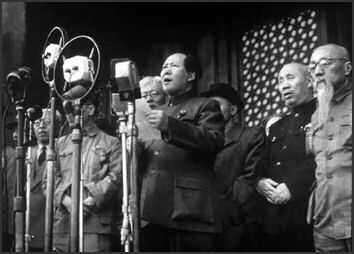
“On another trip in April 1949, I flew to Shanghai, where Father Frank and I met up again. He was preparing to leave for his new mission in India,” she pointed out, “because of the pending Chinese Communist Revolution. During that trip, I remember seeing security everywhere. We stayed at a staff house instead of a hotel, and our shuttle bus to the airport had bars across the windows. People were clamoring to leave the country. At the airport, people thrust letters at me to mail to loved ones. I remembered journalists from Time Magazine and the New York Times among our passengers, also leaving the country before the takeover.” (On October 1, 1949, Chinese Communist leader Mao Zedong declared the creation of the People’s Republic of China (PRC).)
1951 was an eventful year. Korean War armistice negotiations began; King Abdullah I of Jordan was assassinated; the Great Flood of 1951 reaches its highest point in northeast Kansas; MGM’s Technicolor version of Showboat premiered at Radio City Music Hall; J.D. Salinger’s “Catcher In The Rye” was published in the U.S.; and Judy Garland opened the first of 14 concerts in Dublin.


For Madeline personally, 1951 was a year that would change the course of her life. She received her treasured gold Pan Am five-year pin and met her handsome 6’2″ husband-to-be – Pan Am co-pilot Charles “Chuck” Smith. She first met him in San Francisco Flight Operations and later met up with him again in Honolulu. They spent 19 days on their flight pattern to Sydney, Australia, and Auckland, New Zealand.
Soon after, they married, ending her Pan Am career. (Back in those days, girls were required to retire once they married.)
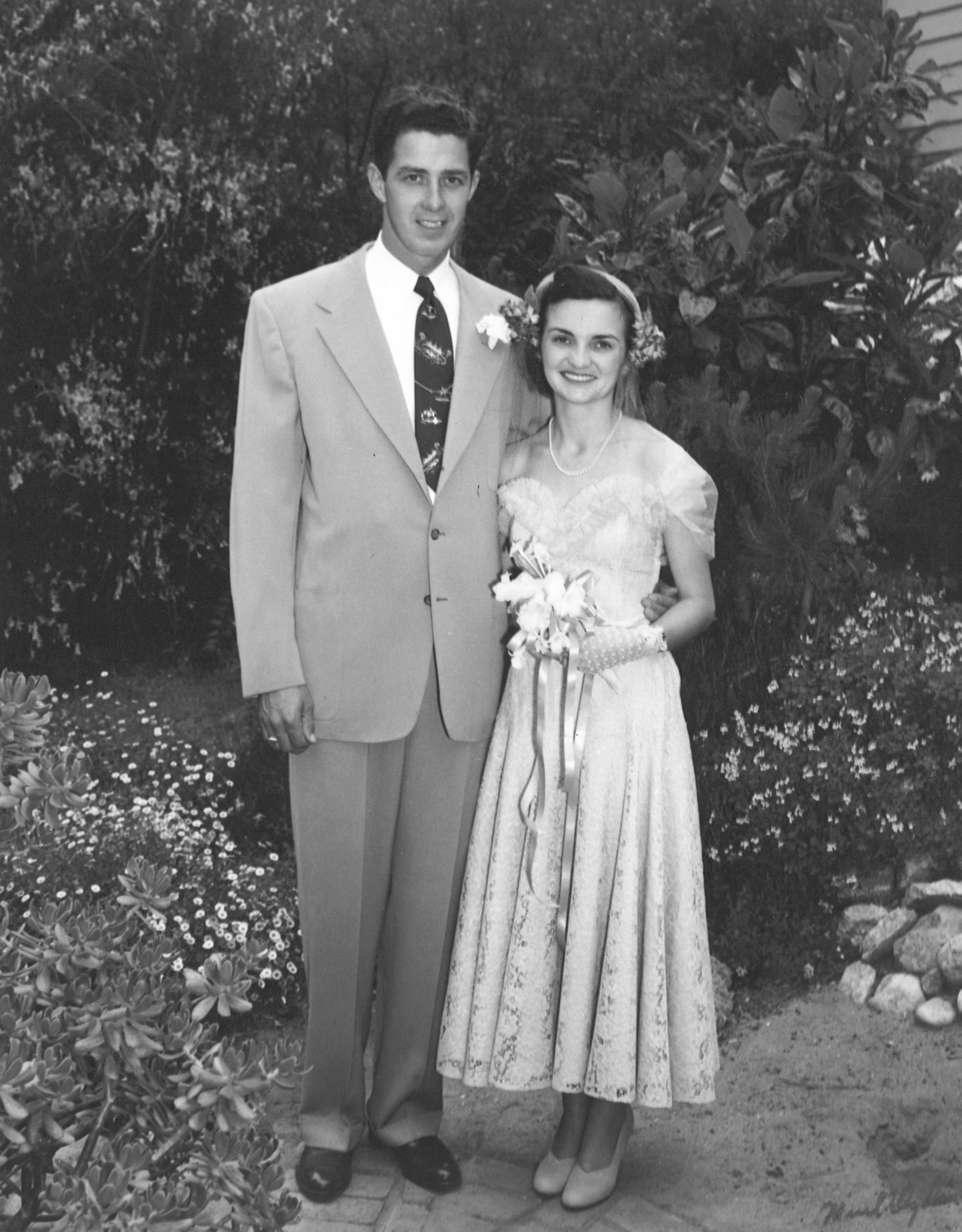
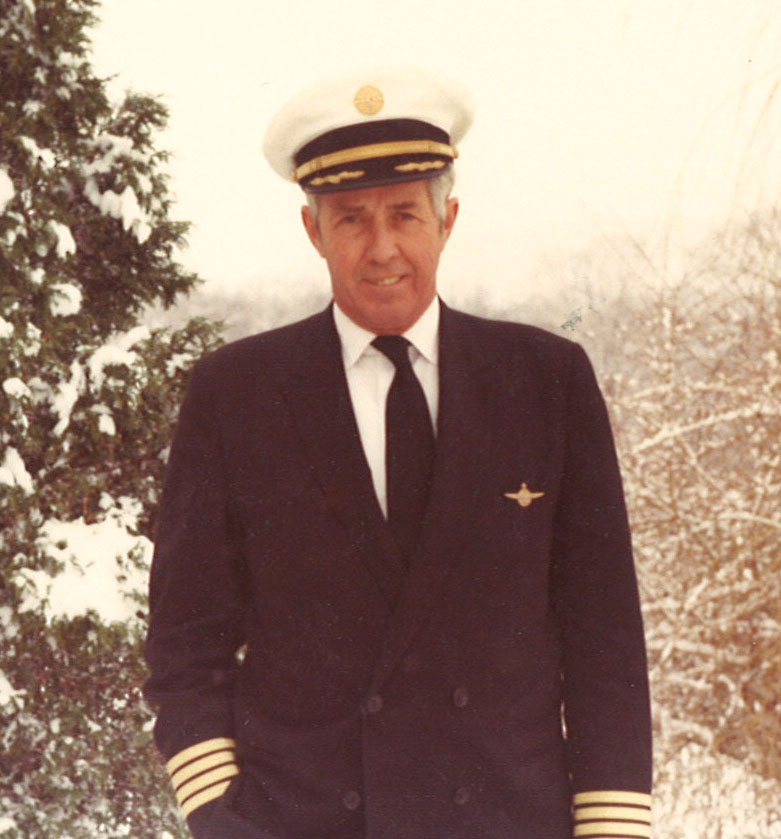
Madeline has happy memories of her flying days, but one Ketchikan, Alaska tragedy will always be remembered with sadness. On October 26, 1947, Pan Am Flight 923 (a DC-4) crashed, killing all 18 passengers and crew on board. Reflecting on the incident, she said, “Al Monsen, a bush pilot before joining Pan Am, considered an exceptional flyer, encountered a severe storm and was unable to clear Tamgas Mountain on Annette Island. One of my classmates Helen Darrah was on board, as well as our supervisor Mary Chidiac, who had just checked me out ending my six-month probation.” She hesitated, shook her head, and for the first time during our conversation I saw her eyes mist over as she continued saying, “I felt so close to both of them. It affected us all!”
#####
Mary Lou Moore Bigelow, former Pan Amer (1962-1968) is a Seniors Real Estate Specialist® with Bowes Real Estate in Arlington, MA. From 1990 to 1995, she founded and edited “Economic Development,” a supplement for the New England banking and real estate periodical Banker & Tradesman. Her salute to Pan Am “A Pan Am Memoir 1962-1964” is available along with her “Mary Lou Bigelow Show” TV interviews at www.maryloubigelow.com/tv, on YouTube and Vimeo. In 2014, she participated in the Smithsonian Channel Documentary “I Was a Jet Set Stewardess” with fellow Pan Am flight attendants. She is currently vice president of the Boston Chapter of World Wings International, a steering committee member of the Massachusetts Air & Space Museum, and an active member of the Aviation Museum of New Hampshire. She welcomes speaking engagements on real estate and aviation. Her passion is to keep the good name of Pan Am and its importance to aviation history alive. Contact her at maryloubigelow@gmail.com.
Clipper Crew Note:
Flight 923 was a regularly scheduled Pan American Airways flight between Seattle and Juneau, with a scheduled stopover at Annette Island Airport. The aircraft left Seattle at 10:30 A.M. on October 26, 1947. It was scheduled to arrive in Juneau around 3:00 P.M. that same day.
There were five Pan Am crew members aboard: three cockpit crew and two pursers. The pilot was Captain Alf N. Monsen, a veteran pilot with 13,565 hours of flying time. His copilot was First Officer Laurence A. Foster, another captain who was serving as copilot and first officer due to personnel reductions at Pan Am. The flight engineer was C. L. Dunwoody.[2]:2-3
Click here to read more about Flight 923.


What a wonderful recounting of life in the skies in the 40s and 50s.. Times like those will never come again. Treasure your memories and treasure life. Find joy and hold it close.
Lovely article! Madeline will be forever young due to her brightness of spirit. Loved spending summers and holidays with her, Uncle Chuck and their wonderful kids. Love you Madeline!
Many thanks. I am really looking forward to know more details about this Clipper 1 flight. I would really appreciate if any survivor may narrate the incident. Is there any accident investigation report available anywhere !
Here is a link with more information about Flight 1: https://aviation-safety.net/database/record.php?id=19680612-2. We are researching to see if we can find the name of the stewardess who perished. We do know the Captain’s name was J. O’Malley.
Here is another link to a news article https://newspapers.library.in.gov/cgi-bin/indiana?a=d&d=TDB19680613-01.1.1.
A priceless article, with the special mention of Calcutta (now Kolkata). I have heard about Kolkata’s glorious past as a busy international stop-over airport. Being from Kolkata and an ex-Air Traffic Controller, I wish there will be many more mention of “Calcutta”, in similar tales. Worth to mention that in 1968, a PanAm Boeing 707 (Clipper Caribbean) undershot the Dum Dum Airport (Calcutta) runway and crashed with 6 casualties, one of them being a stewardess. It is told that she died while trying her best to evacuate the fellow passengers first, instead of caring for her own safety. I wish if anyone from PanAm might throw some light, as to what was her name and any other detail about the other crew.
What a great article. Chuck and Madeline Smith were and are close family friends…..Our family , and my Dad was also Pan Am, Chuck was best friends with our Dad, J Ned Corman…..and we spent many years, holidays and events together.. I’m so happy to learn that Madeline is alive and kicking….she is a delight, then and always……..
Sian Lindemann
Also a Pan Am Flight Attendant 1978 to 1987 in Honolulu….
This all brings back such fond memories for me too……with travel to so many places mentioned here.
Thank you for taking the time to write this article
Oh wow! Such memories! I didn’t fly for Pan Am but I flew for American Airlines based out of Dallas…I was born and lived in Hong Kong…I desperately wanted to fly for Pan Am but you had to be 21…American only 19….I went to Stephens College in Columbia, Mo. and took every airline related class I could!! I flew from 1958 to 1960 when I got married and had to quit!! I loved my job! I actually worked as a “ground stewardess” in Hong Kong for Pan Am during my summer vacations when I would fly home to HK from Stephens…memories…memories…thanks for sharing yours!! xo
What a terrific story! I started flying EX SEA in 1964 and some of those primitive situations in Alaska existed even during the jet age. The descriptions of Calcutta are priceless and I remember flying with Captain Chuck Smith when I was based in HKG and flying the R&Rs to SE Asia. Madeline, you are an inspiration and Mary Lou told your story beautifully!!
Wow. So enjoyed reading this. Thank you.
I truly loved reading this article. It literally brought tears to my eyes caused by the memories that arose. I was base in JFK and LHR starting 72 and flew mainly Flt 002and Flt 001. Even though times had developed flying the pacific was unforgettable. Thank You for this wonderful article and thank you Madeline for sharing it
I flew with Pan Am in the years 1966 through 1968. It was an amazing education after my five years at the University of Georgia! I treasure the memories of adventure to this day. ✈️
Thanks Mary Lou and Madeline for this fascinating tale! I am constantly amazed by Madeline’s YOUNG spirit and the fact that she wears high heels with such comfort and style when I, a quarter century younger, wear low shoes!! I am also embarrassed now, for not questioning Madeline more closely about her Pan Am career! Wonderful stories and a very romantic life for sure!!
Wonderful information about a fantastic time in flight history. Thank you so much, it is quite amazing the honor and dignity of so many of the people working together.
Absolutely fascinating memories…I flew with Pan Am from 1965 to 1968 LAD NY and then transferred to LA as purser. I also remember PanAm very fondly .